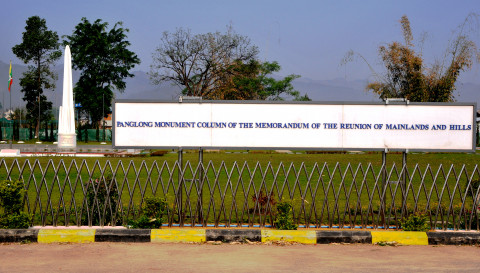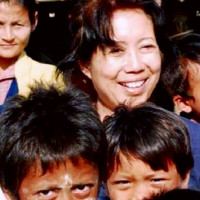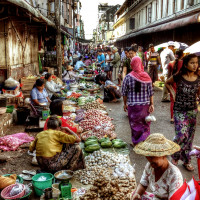Bridging conceptual differences vital to end ethnic conflict
Regions
While the first move of Aung San Suu Kyi has been to form a national reconciliation government, followed by restructuring, streamlining and planning so that her administration can function, the handling of the country’s faltering peace process has now risen to become one of the most urgent and essential challenges on the NLD's must-do list.

Tom Kramer
Introduction
As the National League for Democracy finally took over the reins of administration from the quasi-civilian government of President Thein Sein, the question of fulfilling its campaign promise to usher in a “time for change” has become the most pressing core issue that it has to tackle for the party and its principle leader, Daw Aung San Suu Kyi.
While the first move of Aung San Suu Kyi has been to form a national reconciliation government, followed by restructuring, streamlining and planning so that her administration can function, the handling of the country’s faltering peace process has now risen to become one of the most urgent and essential challenges on the NLD's must-do list.
Before going further, it is necessary to briefly touch on Burma's historical backdrop and the conceptual differences among the key stakeholders, so that the problematic ethnic conflicts, which have plagued the country for so many decades, can be better understood.
Historical backdrop
The country we know today as Burma or Myanmar, as it was termed in 1989 by the then military regime, is a relatively new political entity in history that is made up of at least three countries or territories with legacies of self-governance or independence: namely, Burma Proper (which became Ministerial Burma under British rule), the Karenni States and the Shan States. Reflecting this history, leaders of the Shan and Karenni States joined with political actors in Burma Proper in their struggle for self-determination from colonial rule and jointly attained independence with territories inhabited by other nationalities in the new union on 4 January 1948. As a guarantee of autonomy, both the Shan and Karenni (today Kayah) States were granted the right of secession under the 1947 Union of Burma constitution.
Prior to independence from the British, representatives from the Federated Shan States, Chin Hills and Kachin Hills under the British Frontier Areas Administration signed an agreement with an interim Burmese government, represented by U Aung San (the late father of Aung San Suu Kyi), in Panglong on 12 February 1947 to build a union vested with administrative and financial autonomy, equality and democracy for the non-Bamar (Burman) nationality groups.
It should be noted that what is known as the “Shan State” today was then known as the “Federated Shan States”, including the Karenni States, under British rule. Meanwhile what have become the present-day ethnic states of Karen, Mon and Rakhine (Arakan) were generally treated or designated as part of Burma Proper by the colonial authorities, and they were not represented at Panglong. This means that, while the Panglong agreement has historic resonance as a legal accord of inter-ethnic equality and unity, not all nationalities felt included by its scope.
From the period of 1948 to 1962, the country was governed by a parliamentary multi-party system that was federal in form but unitary in practice. As conflict spread to many regions, this proved a far from satisfactory solution. Thus, in order to correct this constitutional flaw, a proposal to amend the 1947 constitution was developed by different nationality leaders so that the political system could be made more explicitly federal. Spearheaded by the Shan State government and ratified by the All States Unity Organisation at Taunggyi in 1961, the federal proposal argued that the constitution should be amended so that Burma Proper would itself be transformed into a constituent national state like the other ethnic states. In this way, it was hoped to end the usurping by ethnic Bamar leaders of the powers of union government, which had led to the economic, political and administrative marginalisation of nationality peoples in other parts of the country.
However, before the parliamentary debate to amend the constitution could properly begin, the national armed forces, known as the Tatmadaw, staged a military coup in March 1962. The stated aim of Gen. Ne Win and the coup leaders was to prevent the disintegration of the country but the results were very much the opposite. Not only did the military government abruptly end the nascent federalism and democracy in the post-colonial state but it also pushed the simmering dissatisfaction of the non-Bamar ethnic groups into a full-blown war of resistance across the country. Opposition also continued among the Bamar majority to military rule, but it was in the borderlands that conflict and political demands for ethnic reform remained most acute.
Thus Gen. Ne Win and the Tatmadaw ended the last legal effort to ward off the growing conflicts between Bamar and non-Bamar peoples by preventing amendments to the 1947 union constitution, which was now unilaterally abrogated. It was to be another half century before the term “federalism” was allowed again by Tatmadaw leaders in national political debate. Much conflict, suffering and political breakdown occurred in the meantime.
Differing concepts on political entity, sovereignty and national identity
The conceptual differences between the Bamar political class, including Tatmadaw leaders, and the different ethnic nationalities, start with how “Burma” or “Myanmar” is historically seen and defined.
Since 1962, successive military-dominated governments have regarded the modern state as an existing unified nation since the reign of Anawrahta at Pagan nearly a thousand years ago. As such, non-Bamar peoples are treated as minority groups whose aspirations for equal rights need to be limited or controlled lest they break up the country. In contrast, non-Bamar nationalities maintain that the Union of Burma is a newly-developed territory and political entity, based upon the principles of a treaty, the Panglong Agreement, whereby independent territories that had been annexed into British India merged together on an equal basis at the departure of colonial power in 1948.
In theory, there is a degree of ethnic symmetry on the present political map where seven states are demarcated for the largest nationalities (Chin, Kachin, Karen, Kayah, Mon, Rakhine and Shan), while there are seven regions (formerly divisions) where the Bamar majority mostly live. But, under military domination and the country’s highly centralised politics, there has yet to be any genuine autonomy or equal balance in national politics.
Today these different perceptions continue to be highlighted at Panglong where the monument to this historic treaty proclaims “the reunion of mainlands and hills”. However neither should the “mainlands” be considered the Bamar-majority core of the country nor the “hills” peripheral or secondary territories that are inhabited by non-Bamar groups who had been under the pre-colonial rule of Bamar kings. Rather, the modern state of Burma was agreed upon at independence as a new union of equals where political rights would be respected for all nationality peoples. That is what Panglong was supposed to signify. Without such an agreement, the new Union would not have been born.
When discussing inter-ethnic relations, it should also be stressed that non-Bamar peoples never consider themselves as being “minorities” as many Bamar and international scholars often address them. In fact, they are neither minorities nor majorities but nationalities who should be treated equally. It is true that the Bamar population is numerically larger than other ethnic nationalities. But this does not, in itself, make the inhabitants of the ethnic states “minorities”. In one of the most ethnically diverse countries in Asia, the term “minority” could also be used to describe Bamars resident in the seven ethnic states or other nationalities living in these territories, but the result would be a profusion of unhelpful “minority-majority” arguments that undermine the political importance of union and marginalise smaller nationality populations.
In essence, the term “minority” has become a discriminatory misnomer, and there is a big difference between being treated as a “minority” and enjoying equal status as a member of a nationality group. Peoples such as the Bamar, Kachin, Shan, Karenni and Chin should be considered neither minorities nor majorities but equal partners who agreed to work together within the new union back in 1948.
Regrettably, such a fundamental challenge in shaping a common vision of equality and shared national identity has never been truly addressed since independence. While non-Bamar peoples continue to believe in a shared-sovereignty and co-independence forged during the struggle from colonial rule, Tatmadaw leaders and much of the ethnic Bamar political class regard themselves as the guardians or sole owners of the country's political sovereignty. In consequence, projections of a common national identity by Tatmadaw officers during the Burma Socialist Programme Party era of Gen. Ne Win and the subsequent “Myanmar” era of the State Law and Order Restoration Council (from 1997, State Peace and Development Council) have never really taken root or been accepted by non-Bamar peoples. Rather, non-Bamar nationalities believe that they have never been asked for their consent on national political change but forced to accept – often to the backdrop of conflict – what successive military-dominated governments have decreed.
In consequence, the struggle for ethnic rights and equality continues in many parts of the country today. Looking back to Panglong, ethnic leaders believe that the achievement of peace, stability and a common national identity has to be accompanied, and guaranteed, by the rights of self-determination, democracy, equitable resources and political power-sharing. Then and only then can a national identity and political system be forged that will become acceptable to all non-Bamar peoples.
For the moment, however, many ethnic nationalities perceive themselves as trapped within the mould of a colonial-like possession by a Bamar ruling elite. Indeed, echoing the British division between Burma Proper and the former Frontier Areas, a new diarchic system of national governance appears to be emerging under political changes introduced after President Thein Sein took office in 2011. While a system of parliamentary administration is being developed in the “mainlands” centre of the country from the national capital at Nay Pyi Taw, the ethnic states remain “hills” conflict zones under arbitrary Tatmadaw rule and authority.
The result is that, during a time of hoped-for political change, many nationality peoples feel marginalised from national political life. The outcome is likely to be continued political instability because military coercion will never answer the demands for equal ethnic rights. Rather, lasting peace and justice can only be achieved by returning to the aspirations and principles for a common identity of union equality for all nationality peoples that were agreed back at Panglong in 1947.
Different outlooks on federalism
Generally, it would seem that, since most of the leading parties and stakeholders have agreed during the past few years on the need to build a federal union to resolve the country’s political failures, there should not be serious problems. But, in reality, the road ahead is likely to be complex and, for the moment, it is difficult to pin down who really wants what kind of federal system.
For example, while Aung San Suu Kyi has personally said on several occasions that genuine federalism is her aim, we still need to know the details of the nuts and bolts on how her party actually stands on this crucial issue. Similarly, the position of the Tatmadaw on a federal union set-up is also unclear in the Nationwide Ceasefire Agreement (NCA) of 15 October 2015 and the preceding Deed of Commitment on Peace and Reconciliation on 12 February 2015. The only promise is to “establish a union based on the principles of democracy and federalism in accordance with the outcomes of political dialogue”. But, as nationality parties question, this could mean anything from the present unitary presidential system and a minimum devolution of power to a fully-fledged federal union with strong state administrations and a weak federal central government.
For this reason, political sentiment remains strong that Tatmadaw leaders only want a unitary centralised system of national politics with limited, but just enough, devolution of power to the ethnic states for there to be a semblance of federalism. As evidence of the Tatmadaw’s thinking, the present Commander-in-Chief Snr-Gen. Min Aung Hlaing has time and again stressed that the military will defend its self-drafted constitution of 2008 with its life and refused, to date, for any meaningful amendments that might diminish its dominant role.
As for the ethnic nationalities, a consensus has emerged in recent years of preferring a system along the lines of “building a federal union based on national states, with equality, rights of self-determination and democracy” which, in political terms, would mean a political system that is in a “fully-fledged federalism” category. They have faced, however, an uphill struggle in advancing their views, and critics – both ethnic Bamar and international – have been of the opinion that the different nationality movements do not really know what kind of political system they want except to parrot the cause of “genuine federalism”. But this is to disregard history and negate the justice of the ethnic nationality cause, which subsequent generations of political leaders have pursued in good faith.
The reality is that nationality parties have always had a federal vision, and it is none other than the model of national state-based federalism drawn from the three historical documents, which many actively participated in during the course of the independence struggle and subsequent initiatives at post-colonial nation-building. These are the 1947 Panglong Agreement, 1947 Union of Burma constitution, and 1961 Federal Proposal of all ethnic nationalities. True, innovation is needed that is in tune with the changing times. But it is totally untrue that the ethnic nationalities have no idea what kind of federalism they want to be established. Rather, it was the ending of federal reform and democracy that underpinned state failure and spread of ethnic conflict in the 1960s, and it is vital that the same errors and marginalisation of ethnic rights do not happen again.
This does not mean, of course, that achieving national consensus during the life of the next parliament will be easy. Even before political bargaining begins, there are likely to be a number of sticking points, including smaller nationalities, such as the Ta-ang and Wa who also have “state” aspirations, or arguments over the question of whether there should be eight states (the present seven ethnic states and a new Bamar state) or a continuation of the present seven ethnic states and seven regions. In particular, ethnic nationality parties continue to be concerned that, in a genuine federal system, usurpation of the powers of the union by leaders and vested interests in the centre of the country, as has happened since the 1950s, must be prevented.
This latter issue is likely to be especially difficult. Since independence, the territories of Burma Proper or Ministerial Burma of the colonial era have grown significantly in national dominance, firstly by their transformation into seven “divisions” under the 1974 constitution of Gen. Ne Win’s Burma Socialist Programme Party constitution and, secondly, by their promotion as individual “regions”, with rights equivalent to the ethnic states, under the military-drafted 2008 constitution. Thus as the imbalance of power distribution grows between a “Bamar-majority” centre of seven regions and “non-Bamar” periphery of seven states, many nationalities are continuing to press for the creation of a Bamar State so that an equal state-based federal union, as envisioned by our founding forefathers, can finally be materialized.
This is not simply a question of political idealism but a reflection of how the Union of Burma came into being and a vision of how it can successfully progress, with equality and security for all peoples, into the future. No part of the country can be considered truly mono-ethnic, and territorial divisions will not provide the answers to questions that are political and attitudinal at their root. As the bitter experience of conflict warns, it remains vital today that the ethno-political landscape is reframed in a way that restores the foundations of equality that were agreed upon at independence.
Failed nationwide ceasefire
Many opinions can be heard as to why the nationwide ceasefire process of President Thein Sein did not reach to final agreement. But for many nationality parties, the failure is due to a sadly familiar cause: a lack of inclusiveness and sincerity on the part of the Tatmadaw leaders who are buttressed in power by their military activities in the conflict-zones and look upon the ethnic armed organisations as “outlaws” or “insurgents” rather than nationality resistance groups that are fighting for a political cause.
On this basis, it is not surprising that many obstacles have occurred along the way. The Commander-in-Chief Snr-Gen. Min Aung Hlaing, for example, has repeatedly stated the need to adhere to the military-drafted 2008 constitution and for ethnic armed organisations to accept a process of “disarmament, demobilization and reintegration” (DDR), which implies that they must disband or become part of the Tatmadaw’s Border Guard Forces or militia units which have proliferated in many conflict-zones in recent years. Such an outlook disregards the fact that ethnic nationality leaders want political solutions, not surrender or a deepening of militarisation among their peoples.
Another unsuccessful point has been a twisted logic of “putting the cart before the horse”: i.e. insisting on getting different ethnic forces to individually sign a “nationwide ceasefire agreement” first, before agreeing on the demarcation of troops, a military code of conduct and a real basis for national political dialogue, and without joint-ceasefire monitoring and enforcement mechanisms in place. Equally concerning to nationality leaders, the Tatmadaw has continued military offensives against a number of ethnic armed organisations throughout the peace talk period, including the Kachin Independence Organisation, Shan State Progress Party/ Shan State Army, Ta'ang National Liberation Army, Myanmar National Democratic Alliance Army (Kokang) and Arakan Army.
To justify its “security first” stance, Tatmadaw officers have advanced different reasons for why some ethnic forces have been rejected as negotiating partners during Thein Sein’s NCA process. But this does not go down well among conflict-torn communities where there has been significant loss of life and the number of internally-displaced persons has continued to grow. As all sides know, the present conflict-zones in the northeast of the country were promoted as model ceasefire areas of peace under the former SLORC-SPDC government, and there must be other reasons – economic as much as political – as to why armed conflict has intensified during a supposed time of national peace talks.
Against this backdrop, less than half the active ethnic armed organisations in the country signed President Thein Sein’s NCA last October, and virtually all the major groups stayed away, hoping that the November general election and emergence of a more democratic and representative government will provide the next steps on the road to achieving nationwide peace.
Possible compromise?
The present national landscape is uncertain. So far the NCA, which is, in effect, just a partial ceasefire, has been signed by just eight forces from a total of twenty-one that have been promoted for nationwide signing. But even this partial NCA has not been able to achieve real peace and normalcy during one of the most important times of transition in the country’s history. The ongoing conflicts in the Kachin and Shan States and the Tatmadaw’s massive deployment of military resources, including attack aircraft, show that we are still a long way from a political settlement and durable peace.
Many solutions have been proposed that are often complex in both theory and detail. But, as a starting point, I would suggest that it is time to consider whether the underlying conceptual differences – or should we say the “accepted values” – of the warring parties might be the main cause of such enduring animosity and conflict. As we examine something so fundamental in our national politics and societies, we should ponder on how we can find reconciliation and understanding among ourselves. For if we cannot agree upon even the ownership of national sovereignty or a shared historical understanding of the political entity that has become modern-day Burma/Myanmar, it will be hard to find real solutions.
From the ethnic nationalities' point of view, the self-proclaimed right of the Bamar-majority Tatmadaw to claim ownership of national sovereignty is incorrect, because they consider that they own an equal share and sovereignty in such a multi-ethnic country must be jointly shared. Likewise, the Tatmadaw's version of the modern-day Myanmar as a continuation of an existing unified nation since the reign of Anawrahta – as evidenced by the towering statues at Nay Pyi Taw of the three kings Anawrahta, Bayinnaung and Alaungpaya – do not augur well for hopes among the different ethnic nationalities of enlightened and pro-federal reform.
In contrast, nationality parties see Burma as a modern and relatively new political entity that they have voluntarily helped to build and in which they must have an equal say. Certainly, they do not see themselves as the underlings of a Tatmadaw that projects militant traditions back into a distant past. In the same vein, when the present-day Tatmadaw, which is Bamar-dominated, enters ethnic nationality areas and starts military offensives under the pretext of protecting sovereignty and upholding national unity, this seems illogical and rings hollow in the ears of local peoples because they consider such operations an occupation and militarization of their homelands that must be resisted.
The situation, however, is not without hope. A new mood for change is evident in many parts of the country, not least among the younger generation. Aung San Suu Kyi’s calls for a “second Panglong” and a 21st century Panglong Agreement to overcome ethnic conflict is an encouraging first step if we are to build a society that can co-exist and co-habit in harmony together. And now that Aung San Suu Kyi has been entrusted by the national mandate of the people to take forward the task of realizing their desire for peace and democracy, many citizens hope that a new momentum is growing for much deeper political change.
For the moment, the Tatmadaw’s response is not certain, but leaders of the ethnic armed organisations are already preparing for more substantial peace talks in the future. In the meantime, the newly-created Ministry of Ethnic Affairs could be energized and vested with more rights than the law of safeguarding the ethnic nationalities, which was promulgated during Thein Sein's presidency. In particular, it could be granted the rights and task to help push, cooperate and coordinate with all the relevant ministries in the country – including the Tatmadaw-controlled Home, Defence and Border Affairs ministries – to achieve peace, stability and reconciliation sooner rather than later during the life of the next parliament.
In summary, after so many decades of disappointments and suffering, our country could indeed be on the brink of better change, if leaders and parties on all sides commit themselves to the cause of achieving ethnic peace and reform. But it goes without saying that altruism, political will and the genuine wish to compromise are essential ingredients that are needed to overcome all the obstacles on the difficult road ahead. Without these, we will continue to muddle through, as in previous political eras, without ever coming nearer to fulfilling our long-held aspirations for national peace, harmony and justice. In this endeavour, it is vital that all parties reflect on ways to bridge the conceptual differences in history that have come to underpin and sustain conflict, and this should be accompanied by constructive political dialogue that is based on recognition of the necessity and mutual benefit of national power and resource-sharing. It can be done and is very much what the leaders of the peoples at independence agreed and aspired to.
Sai Wansai is a Shan political analyst and the ex-General Secretary of the former Shan Democratic Union.
This commentary is part of a TNI project funded by Sweden.



